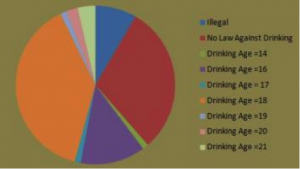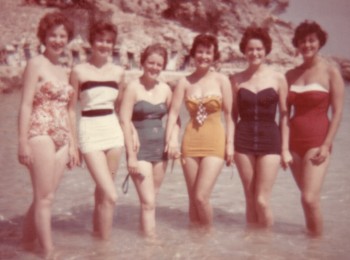Note: This is an extremely rough rough draft. Lots of facts, less analysis and I still have to add in text citations. Don’t judge me.
Questions: Any tips/insights you think i should add or discuss in my paper.
I’m gonna focus this paper more around the shift in sexual freedom? Thoughts?
Imagine going to the beach today. I’m sure you’d expect to see a lot of skin, tons of bronzed beauties bouncy around in minimal fabric, swimming freely, and fixing tops as waves nearly take them off. Now imagine the beach nearly a hundred years ago and place one of these Victoria’s Secret wearing bikini girl right by the shore. This girl, so fitting in todays culture, would be shunned and most likely arrested. Swimwear has dramatically shifted in the past century. From full costumes to one-pieces to bikinis, bathing suits have changed dramatically and lost much fabric along the way. This dramatic change parallels the shift in attitudes on modestly, feminism, sexual values, youth, fitness and independence.
During the Victorian period, 1837-1901, bathing suits were actually known as bathing costumes. These outfits reflected the extremely modest culture at this time. The Victorian age was filled with stern principles, family values, and sex was not openly discussed or broadcasted. Typically, women wore heavy dresses made of dark wool with a corset underneath, which effectively hid the womanly figure. After getting immersed in the water, the material became very heavy and this led to a slight shortening in the length of the costumes (how risqué); however, dark stockings always covered legs. This bathing outfit nearly had as much fabric as a normal outfit. As social freedoms for women gradual increases, more cloth was eliminated from the outfit, such as sleeves by the 1900s (Bathing costumes). However, failure to adhere to the acceptable customs resulted in scandal or arrest. For example, in 1907, Australian swimmer, Annette Kellerman wore a knee-length, sleeveless, one-piece bathing suit with opaque black stockings on a New Jersey beach and got arrested (bathing costumes).
In the 1920’s swimwear began to rapidly shift towards the one-piece bathing suit. Movies began to feature “bathing beauties,” who wore more revealing and exaggerated swimwear for the time. These movie figures inspired bathing girl parades and contests, such as the very first Miss America pageant in Atlantic City, NJ in 1920. Swimwear’s purpose was shifting from covering up a woman’s figure to highlighting it. Also, women gained more independency after World War I and were fighting for gender equality in voting rights, divorce laws, and the work field. Men were allowed to show their legs in swimwear, so women began to fight for their gender rights. As a result of the popularity of the one-piece suit, many laws were passed to forbid female leg exposure in the United States, and numerous arrests were made on beaches. However, as these laws were massively disobeyed, public standards began to shift and accept the change. The rise of Hollywood further influenced swimwear in the 1930’s as the public began to idolize and look up to movie stars and their fashionable swimwear. Pinup pictures, shots of beautiful girls in provocative clothing meant to inspire the troops during WWII, further shifted the bathing suit to what it is today. Betty Garble’s famous bathing suit pinup featured her looking sweet, innocent, and sexy in a one-piece. The ideal women and her role became influenced by these popular shots. They signified that men desired women for their sexual appeal rather than intelligence. The one-piece’s popularity soared as more woman desired to please the men around them.
The scandal of the one-piece was nothing compared to what arose in the 1940’s: the bikini. During WWII the US government encouraged the rationing of clothing to conserve fabric, and bathing suits with bared midriffs were sold. In 1946, for fashion purposes, the less conservative, triangle-top bikini appeared, designed in Paris, France (bikini long). Named after the atomic bomb tests taking place in Bikini Atoll in the Pacific Islands, the bikini was a shock to the standing culture and was banned and/or shunned in many countries (bikini). The bikini did not become popularized or worn on beaches until the 1960’s. The manufacturing of spandex increased the functionality of the suit during this time and allowed it to be much tighter. Famous movie actresses, songs, and other aspects of pop culture also played a huge role in making this an acceptable thing to wear in public. The loosening of sexual values and emphasis on youth culture matched the increased popularity in the suit as well. Sports Illustrated published their first swimsuit issue around this time and the bikini craze grew as well as shifting views of modesty.
The shift did not end there. The bikini began to ration off even more cloth. The string bikini arose in the 1970’s, replacing hip hugging briefs to pieces of fabric with strings (bikini short). The 1970’s and 1980’s were a time of a new fitness and exercise craze, explaining the even more revealing swimsuits. which were focused to show off toned butts and trim bodies. These revealing and skimpy bathing suits have not disappeared. Bathing suits styles today feature barely covering bottoms, and highly padded, push up tops. A bathing suit is the ultimate way for a girl to nearly reveal her entire body to the public and tell the world how comfortable she is in her own skin. Victoria’s Secret fashion show’s broadcast numerous models walking down the runway in barely anything, accentuating nearly every curve they have (or lack) in a tiny bikini.
Overall, the shift in bathing suits throughout the past century is extremely dramatic. Women have been penalized for showing leg in the past to being ridiculed for not wearing a bikini on the beach today. This paradigm shift is the result of many different factors. These include equality of the sexes, a loosening of the sexual culture, shifts in modesty, historical events such as wars, and a focus on the health and fitness of the body. A bathing suit is no longer intended to cover up, it’s intended to reveal and show off the beauty of the woman’s body. Will bathing suits continue to decrease in modesty and fabric or regress back to more coverage? Only time shall tell, but for now, the bathing suit is an acceptable and embraced part of many cultures. It reflects the views of the time, the power and freedom women have today.




